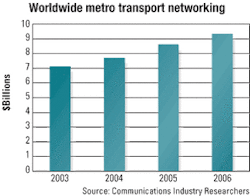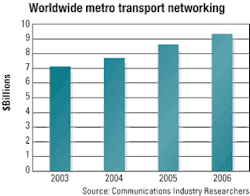Strategies that conform to the realities of the marketplace and an unrelenting desire to maintain credibility will differentiate successful players from those facing extinction, especially during the telecom market downturn. More than 40 metro vendors will play for massive stakes in a worldwide market that includes SONET/SDH, WDM, Ethernet, and routing gear. The metro transport networking equipment market is projected to grow to $9.3 billion in 2006 from just over $7 billion in 2003 (see Figure).
To get a piece of that pie, many equipment manufacturers will need to overhaul their communications with the outside world and, even more important, with customers. There is still far too much compliance with standard procedures that should have been discredited and abandoned long ago. Service providers tend to act politely during suppliers' canned presentations, but this same audience often jokes about the absurdity of it all after these meetings.
There are obvious benefits from a business perspective to being as honest and forthright as possible, but only a small number of metro equipment suppliers possess the courage and conviction to separate their own rhetoric from that of the herd. It is clear that gross exaggerations and misinformation were put forth consistently over many years even by supposedly scrupulous public companies.
The eradication of supplier estimates of the "long-term" savings offered by their technology is a major step in the right direction, especially at a time when low first cost is everything to the carriers. Historically, only negligible reductions in operational expenditures have ever been proven anyway.
It's amazing so many suppliers, especially newcomers, ignore the path taken by just about every successful company over the last 25 years. Metro equipment suppliers must understand what the present-day network requirements are and build only around those needs. It will be hard enough to succeed even with a pragmatic approach, but disaster is almost assured if a vendor bets on supplying a "new" or "future" technology to the mostly staid public networks.
That means, for instance, not arguing the hypothetical benefits of Ethernet in the metro core when that application is not really going to be considered by the decision-makers at the traditional service providers. Superficial signs of potential success, such as press releases from carriers, feedback from personnel trying to justify their existence in the carrier laboratories, and mention of a particular functionality in requests for proposals, does not usually translate into dollars spent. Basically, success is about finding the most likely way of making money now and not getting anywhere close to the bleeding edge. Furthermore, by focusing on a need that is fixed and known, a company's message is likely to be consistent, rather than changing with the way the wind is blowing.
To achieve these undeniably attractive goals—conservatism, restraint, and pragmatism—a vendor's executive management must develop humility and a realistic view of the market. A number of startups are still in a 2001 time warp, unwilling to give up the call for goals like greater bandwidth efficiency—a notion that did not fly even during the optical-fever days.
Suppliers that lose their focus on practical matters may eliminate their company from contention. Some players put a lot of emphasis on options that admittedly are attractive, but which don't make much of a difference in the sale. These same companies are not addressing fundamental matters like how easily a technician can get through a narrow aisle in an older central office.
Moreover, there is an incredible amount of laziness and obliviousness in the critical requirement of network/element management, so much so that this functionality offers a means in which a manufacturer can truly differentiate itself from its competitors. Put simply, network management is the principal factor in a service provider's success. It allows service providers to proactively determine specific problems completely and accurately before any glitches actually affect the customer and guarantee the performance promised in their service-level agreements.
Of course, network and element management systems are not glamorous, but the significance of a particular functionality is often inversely proportional to its sexiness. Instead of giving the impression of being averse or apathetic to dealing with management systems and making this functionality the last stop on the dog-and-pony trade-show rides, the supplier should lead off with these capabilities.
All in all, there has been insufficient introspection by metro vendors about the future effects of insincere rhetoric regarding equipment functionality or hyping utterly abstract benefits of their solutions.Mark Lutkowitz is vice president of optical-networking research at Communications Industry Researchers (Charlottesville, VA).


